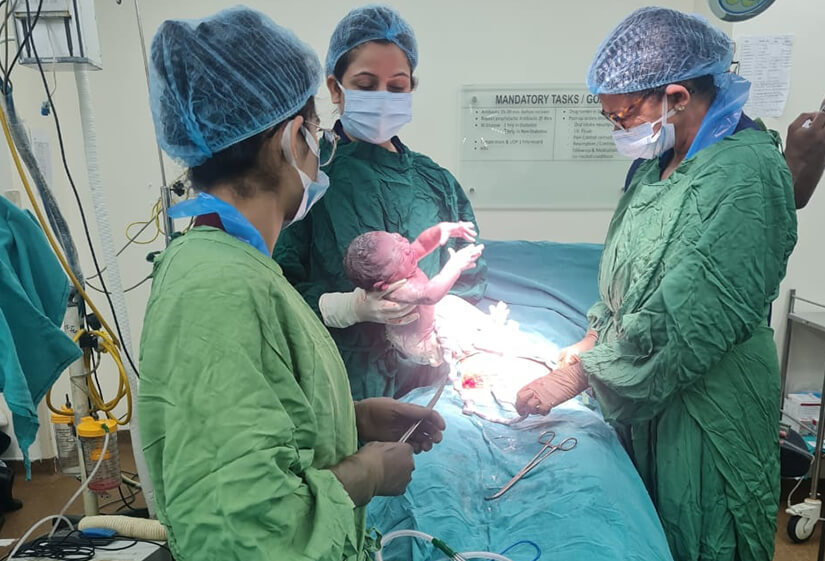When is A Cesarean Section Necessary?
Bringing a little one into the world is an extraordinary journey filled with anticipation, excitement, and, of course, a touch of apprehension. While most births occur through the beautiful process of vaginal delivery, there are times when circumstances call for an alternative route – Cesarean section.
What is Cesarean Section?
A Cesarean section, commonly called a C-section, is a surgical procedure to deliver a baby. It involves making cut in the mother’s abdomen and uterus to access the baby and safely bring them into the world. Unlike vaginal delivery, which occurs through the birth canal, a C-section is a surgical alternative typically performed under anaesthesia through the abdomen.
During a C-section, Dr Rhythm Gupta, the best Gynecologist in Shalimar Bagh, carefully creates incisions, usually horizontally, along the lower abdomen, allowing them to access the uterus. Once the baby is reached, they are gently delivered through the incision. After the baby is safely delivered, the gynaecologist closes the incisions with sutures.
C-sections may be planned or performed as emergencies if complications arise during labour.
Why is a C-section Required?
While vaginal delivery is the preferred method of childbirth in most cases, a C-section may be necessary in certain situations for the well-being of the mother or the baby. Some common reasons why a C-section may be required include:
Cephalopelvic Disproportion: Cephalopelvic Disproportion is a condition where the size of a baby’s head or body is too large to be safely delivered through your pelvis, or it can indicate that the pelvis is too small to accommodate an average-sized baby during childbirth.
Foetal Distress: If the baby shows signs of distress during labour, such as an abnormal heart rate pattern, a C-section may be performed to expedite delivery and prevent potential complications.
Abnormal Positioning: If the baby is not positioned head-first (breech position) or if the baby is in a transverse or oblique position, a C-section may be necessary. Certain breech presentations can be managed with vaginal delivery, but it depends on factors such as the type of breach and the experience of the gynaecologist. Dr Rhythm Gupta, the Best gynaecologist in Delhi, carefully monitors the condition and prescribes C-sections.
Placenta Previa: When the placenta partially or completely covers the cervix, it can cause bleeding and pose risks during vaginal delivery. In such cases, a C-section is usually recommended to avoid potential complications.
Previous C-section: If a woman has had a prior C-section, she may be offered a repeat C-section for subsequent deliveries due to the potential risks associated with vaginal birth after a cesarean (VBAC). However, VBAC can be considered in specific cases based on factors like the type of previous uterine incision and individual circumstances.
Placental Abruption: If the placenta separates from the uterine wall before delivery, it can result in heavy bleeding and jeopardise the baby’s oxygen supply. An emergency C-section is often performed in cases of significant placental abruption.
Non-Progress of Labour: In the case of non-progressing labour or prolonged labour, where the dilation of the cervix ceases or slows down, the thinning of the cervix doesn’t occur, or the descent of the baby along the birth canal halts, c-section is preferred.
Failed Induction: Failed induction of labour refers to a situation where medical interventions are used to initiate or speed up the labour process, but these interventions are not successful in achieving the desired outcome of a vaginal delivery. In such cases, a cesarean section may be necessary to deliver the baby safely.
Meconium Stained liquor: Meconium-stained liquor, also known as meconium-stained amniotic fluid, refers to the presence of meconium (the baby’s first stool) in the amniotic fluid surrounding the baby during labour. Normally, the amniotic fluid should be clear or slightly tinged with white, but when meconium is present, it can give the fluid a greenish or brownish colour.
Failed Vacuum/ Forceps: When a vacuum extraction or forceps delivery is attempted but proves unsuccessful, it may result in the need for a cesarean section (C-section) to deliver the baby safely. Vacuum extraction and forceps delivery are both instrumental vaginal delivery methods used to assist with the birth process when there are difficulties or concerns.
Maternal request: In some cases, women may prefer a C-section for various personal reasons, such as anxiety about vaginal delivery, previous traumatic birth experiences, or other personal factors.
Visiting the best gynaecologist in Delhi can help you to resolve your parenthood issues.
Final Words
Every pregnancy is unique, and the decision to perform a C-section is made by healthcare professionals after careful evaluation of the specific circumstances, weighing the risks and benefits. It’s best to consult with a gynaecologist for personalised guidance based on your situation.
Ready to embark on your journey to parenthood? Contact Dr Rhythm Gupta, the best Gynecologist in Shalimar Bagh, today!












